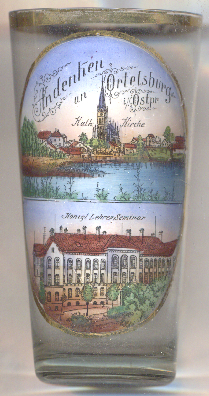

|
| POLSKA | POLAND |
| województwo: Warmińsko-Mazurskie | voivodship: Warmia and Masuria |
| powiat: Szczycieński | county: Szczytno |
Szczytno is situated at an elevation of 252 m in the Masurian Lake District, on the southeastern edge of the Allenstein (Olsztyn) Lake District of the historic East Prussia region. Szczytno is also the seat of the administration of the district (powiat) of the same name. The municipality has a population of about 22,800 (2020).
 Near today's Szczytno are the only known megalithic tombs in Warmia-Masuria. The town was originally a settlement of Old Prussians.
Between 1350 and 1360 Ortolf von Trier, a knight of the Teutonic Order and the Komtur (Commander) of Elbing
(Elbląg), founded a fort, the first mention of which, eponymously named Ortulfsburg, was a document
from 1360, after Ortolf invited Polish colonists from nearby Masovia, among whom the settlement became known as Szczytno. The
settlement grew in size owing to its location on a trade route from Warsaw to Königsberg (now Kaliningrad).
After the Second Peace of Toruń of 1466 it became part of Poland as a fief held by the state of the
Teutonic Order. With its inclusion in the Ducal Prussia in 1525, which remained under Polish suzerainty, it lost its importance as a
border fortress and began to decline. In 1701, Ortelsburg became part of the Kingdom of Prussia. It received its town charter in
1723 and in 1773 became part of the newly formed province of East Prussia. The town became part of the German Empire in 1871 during
the unification of Germany. It became an important centre of the Polish movement in Masuria and resistance to Germanisation. In 1908
Polish writer and Nobel Prize laureate Henryk Sienkiewicz, who popularized the small town through his historical novel The Knights
of the Cross and whose works were published in Mazur, visited the town. Ortelsburg was almost completely destroyed at the
beginning of World War I by troops of the Russian Empire. The East Prussian plebiscite of 1920 resulted in an overwhelming
majority for remaining with Germany. After World War II the town was placed under Polish administration in 1945 under border
changes promulgated at the Potsdam Conference and renamed to the historic Polish name Szczytno.
Near today's Szczytno are the only known megalithic tombs in Warmia-Masuria. The town was originally a settlement of Old Prussians.
Between 1350 and 1360 Ortolf von Trier, a knight of the Teutonic Order and the Komtur (Commander) of Elbing
(Elbląg), founded a fort, the first mention of which, eponymously named Ortulfsburg, was a document
from 1360, after Ortolf invited Polish colonists from nearby Masovia, among whom the settlement became known as Szczytno. The
settlement grew in size owing to its location on a trade route from Warsaw to Königsberg (now Kaliningrad).
After the Second Peace of Toruń of 1466 it became part of Poland as a fief held by the state of the
Teutonic Order. With its inclusion in the Ducal Prussia in 1525, which remained under Polish suzerainty, it lost its importance as a
border fortress and began to decline. In 1701, Ortelsburg became part of the Kingdom of Prussia. It received its town charter in
1723 and in 1773 became part of the newly formed province of East Prussia. The town became part of the German Empire in 1871 during
the unification of Germany. It became an important centre of the Polish movement in Masuria and resistance to Germanisation. In 1908
Polish writer and Nobel Prize laureate Henryk Sienkiewicz, who popularized the small town through his historical novel The Knights
of the Cross and whose works were published in Mazur, visited the town. Ortelsburg was almost completely destroyed at the
beginning of World War I by troops of the Russian Empire. The East Prussian plebiscite of 1920 resulted in an overwhelming
majority for remaining with Germany. After World War II the town was placed under Polish administration in 1945 under border
changes promulgated at the Potsdam Conference and renamed to the historic Polish name Szczytno.
The Catholic  parish church of the Ascension of Our Lady [left, no. 4789: top picture]
was built in 1897–1899 in Gothic revival style. It was consecrated in 1903 and in 1984 was entered in the list register of
monuments.
parish church of the Ascension of Our Lady [left, no. 4789: top picture]
was built in 1897–1899 in Gothic revival style. It was consecrated in 1903 and in 1984 was entered in the list register of
monuments.
The bottom picture on the glass shows a view of the
 Royal
Royal
[https://de.wikipedia.org/wiki/Szczytno, https://en.wikipedia.org/wiki/Szczytno;
http://fallingrain.com/world/PL/85/Szczytno.html;
https://pl.wikipedia.org/wiki/Ko%C5%9Bci%C3%B3%C5%82_Wniebowzi%C4%99cia_Naj%C5%9Bwi%C4%99tszej_Maryi_Panny_w_Szczytnie;
https://ostpreussen.net/2021/03/21/ortelsburg/]
![[scale]](lineal.jpg)